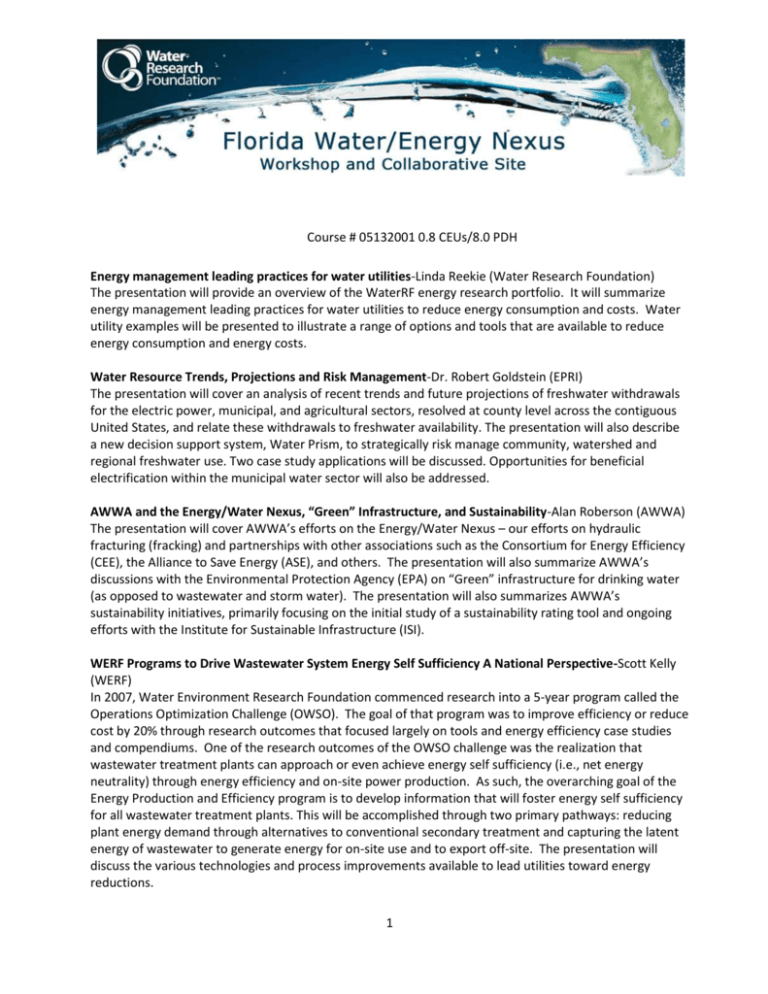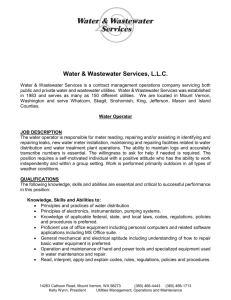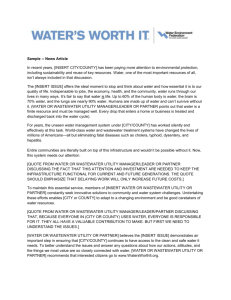Florida Water Energy Abstracts - WaterRF Collab
advertisement

Course # 05132001 0.8 CEUs/8.0 PDH Energy management leading practices for water utilities-Linda Reekie (Water Research Foundation) The presentation will provide an overview of the WaterRF energy research portfolio. It will summarize energy management leading practices for water utilities to reduce energy consumption and costs. Water utility examples will be presented to illustrate a range of options and tools that are available to reduce energy consumption and energy costs. Water Resource Trends, Projections and Risk Management-Dr. Robert Goldstein (EPRI) The presentation will cover an analysis of recent trends and future projections of freshwater withdrawals for the electric power, municipal, and agricultural sectors, resolved at county level across the contiguous United States, and relate these withdrawals to freshwater availability. The presentation will also describe a new decision support system, Water Prism, to strategically risk manage community, watershed and regional freshwater use. Two case study applications will be discussed. Opportunities for beneficial electrification within the municipal water sector will also be addressed. AWWA and the Energy/Water Nexus, “Green” Infrastructure, and Sustainability-Alan Roberson (AWWA) The presentation will cover AWWA’s efforts on the Energy/Water Nexus – our efforts on hydraulic fracturing (fracking) and partnerships with other associations such as the Consortium for Energy Efficiency (CEE), the Alliance to Save Energy (ASE), and others. The presentation will also summarize AWWA’s discussions with the Environmental Protection Agency (EPA) on “Green” infrastructure for drinking water (as opposed to wastewater and storm water). The presentation will also summarizes AWWA’s sustainability initiatives, primarily focusing on the initial study of a sustainability rating tool and ongoing efforts with the Institute for Sustainable Infrastructure (ISI). WERF Programs to Drive Wastewater System Energy Self Sufficiency A National Perspective-Scott Kelly (WERF) In 2007, Water Environment Research Foundation commenced research into a 5-year program called the Operations Optimization Challenge (OWSO). The goal of that program was to improve efficiency or reduce cost by 20% through research outcomes that focused largely on tools and energy efficiency case studies and compendiums. One of the research outcomes of the OWSO challenge was the realization that wastewater treatment plants can approach or even achieve energy self sufficiency (i.e., net energy neutrality) through energy efficiency and on-site power production. As such, the overarching goal of the Energy Production and Efficiency program is to develop information that will foster energy self sufficiency for all wastewater treatment plants. This will be accomplished through two primary pathways: reducing plant energy demand through alternatives to conventional secondary treatment and capturing the latent energy of wastewater to generate energy for on-site use and to export off-site. The presentation will discuss the various technologies and process improvements available to lead utilities toward energy reductions. 1 What the flux: Membranes and Energy-Christine Owen (AMTA) The connection between water and energy use is self-evident when advanced technologies such as membranes are used to treat drinking water. Because membrane separation technology is energy intensive, the energy question receives a great deal of attention from water utility staff who try to manage cost, public perception and expectations. Advances in membrane manufacturing and its materials as well as engineering improvements have decreased the energy requirements for membrane treatment. This talk will examine membrane technology improvements that optimize energy use and frame membrane treatment energy use in the context of other uses. The American Membrane Technology Association is dedicated to promoting the membrane treatment of drinking water accessible and affordable. Energy Efficiency: A New Source of Funding for Water Utilities- Jonathan Gledhill (Policy Navigation) Water and wastewater utilities are seeing increasing demands for capital improvements while traditional sources of external incentives have diminished. Federal support of programs to help water and wastewater utilities has steadily declined since 2000; however, support for other types of capital investments (i.e., energy efficiency) has increased dramatically. As a result, this presentation covers how water and wastewater utilities can tap into these new financial incentives and improve their operations. Attendees will gain an understanding of how financial incentives are changing and what they can do to position their systems to take advantage of the new opportunities. The Watergy Approach: Smart Strategies for Improving Energy Efficiency for Water & Wastewater Utilities and Municipalities- Bruce Lung (Alliance to Save Energy) Water and energy costs are inextricably linked and can be significant. In the U.S., the energy required to supply, treat, transport, and heat water accounts for an estimated 13% of the country’s total electricity consumption, accounting for approximately 290 million metric tons of carbon emissions per year. In some municipalities, drinking water and wastewater treatment can account for up to 35 percent of their annual energy use. Some studies have estimated that the total U.S. savings potential in the water & wastewater utility sector can be as much as 31 billion kWh annually. The water & wastewater utility industry is often overlooked as a specific target of energy efficiency programs. The water & wastewater utility industry faces a number of challenges when implementing energy efficiency measures due, in part, to its capital intensive nature and the interaction of public interests on water treatment. Because of these capital limitations many water & wastewater utilities have not invested in their infrastructure and water delivery assets in as many as thirty years, with the result that many water & wastewater utilities are currently served by aging and sometimes inefficient equipment. As water becomes scarcer due to drought conditions in some parts of the United States and as electric power rates become more variable, improving efficiency in water and energy use will become indispensible for utility managers and end use customers across a variety of economic sectors. 2 Turkey Point Units 6 & 7 – Making Reclaimed Water Work for Nuclear Power-Steven Scroggs (FP&L) FPL is in the process of obtaining licenses and approvals for two Westinghouse AP1000 nuclear generating units at its Turkey Point site in southern Miami-Dade County Florida. From the outset, FPL sought to design the facility in a way that complements the needs and constraints of the South Florida environment. A key design feature is the reliance on treated wastewater from Miami-Dade County Water and Sewer Department. Use of reclaimed water for cooling of power generation is not novel, however the scale of this project presents unique technical, economic and regulatory challenges and opportunities. The presentation will provide a project orientation and focus on some of the specific features of the water supply solution. Florida’s Water Supply Planning Process and the Water: Energy Nexus-Ann Shortelle (Florida Department of Environmental Protection) By 2030, Florida’s demand for fresh water is estimated to increase to over 8 bgd, and traditional sources of fresh groundwater will not be able to meet all of the additional demand. Regional water supply plans are developed by Florida’s water management districts to identify new water supply projects that can, if constructed, provide alternative water sources that are more than adequate to meet the currently projected needs. Continued efforts on all plan components, including traditional and alternative source development and water conservation, are anticipated to ensure that supplies are available to meet 2030 demands. This presentation examines the incorporation of energy needs into this planning process. The Nexus between Water and Energy: Two Case Studies from Palm Beach County, Florida-Bevin Beaudet (Palm Beach County) The presentation will discuss the interrelationship between water and energy and present some statistics that detail the amount of energy that it takes to produce a unit quantity of drinking water and the amount of water that is needed to produce a unit quantity of energy. Two case studies from Palm Beach County Water Utilities are then presented. The first is a project that will capture biogas from the anaerobic digesters of a 35 MGD wastewater treatment plant and use it to generate electricity to help power the plant. The second case study is a reclaimed water system and 19-mile pipeline from a regional 70 MGD wastewater treatment plant that conveys an average of 22 MGD of reclaimed water used as cooling water for a 3800 MW combined cycle natural gas power plant. Both projects provide more sustainable solutions that reduce resource needs for both energy and water production. Energy Water Nexus- From Greenhouse Gases to Utility Energy Optimization Programs-David Bracciano & Maribel Medina (Tampa Bay Water) Tampa Bay Water supplies water to its members through a variety of water sources including groundwater, surface water, stored surface water and desalinated water. The agency develops tools and works with its members to optimize demand side management programs, including estimation of historical and ongoing conservation programs. It developed a methodology to calculate the GHG emissions associated with energy use in water production to determine greenhouse gas emission offsets associated with conserved water. On the supply side, the agency has developed an Energy Program roadmap and is implementing the program in stages to lessen costs associated with energy use within the agency’s operational plan. 3 4








